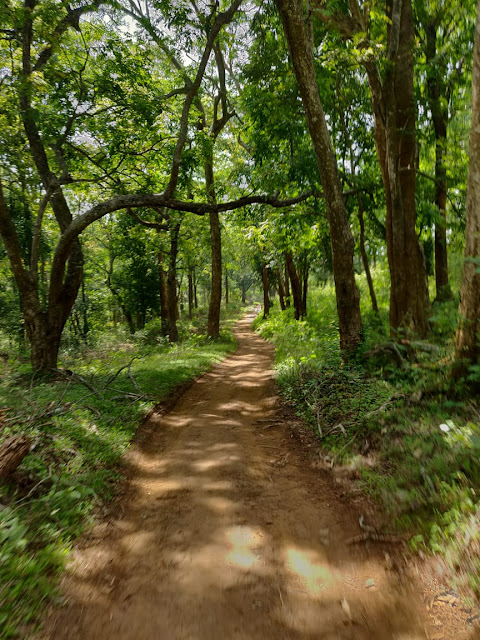Tribals, Hills and Forests - Gudalur expeirence
After a weekend in sittilingi, I started my journey to Gudalur. For me Gudalur was yet another tribal area, and I felt very capable of understanding how it will be. But whenever we feel we know very well, it implies that our ego has taken over our ignorance and we stop learning.
My understanding of myself and my attitude towards tribals changed after this experience.
My understanding of myself and my attitude towards tribals changed after this experience.
The Niligiris welcomed me with with its overflowing essence of nature. The way up the hill, I could see a beautiful, sustainable, greenery which has been harbouring air, trees, animals, and life itself for centuries. I didn't think about the tribals living inside these silent, mysterious forests extending over hectares of land in the mountains.
Before I went into the forest, to get the lifetime experience, the history of few tribals were given by ACCORD - an organisation working for the welfare of the tribals for more than 3 decades.
The mere existence of a number of tribes in the Niligiris itself astounded me.
Paniya, Kaatunayakkan, Bettakurumba, Mullakurumba, Thoda and much more.
The way they have organised themselves, their language, life style, occupation, culture, art, dance, songs, their relationship with forests and their rich identity made me feel less, about our so called 'non tribal' history.
Mulla kurumbas are very good farmers. Kaatunayakans don't farm at all - the word 'kaadu-forest' in their name itself signifies their interdependence with the forests. They are extremely well versed in honey collection. And each tribe can be written about in a detailed way.
Our group, with 5 medical students, two doctors was led by the health animator (works for the ASHWINI - health initiative). We ventured into Chembakolli- a kaatunayakan village which was an hour away from Gudalur. Since we went through the ASHWINI hospital, we weren't questioned by the forest guards. Otherwise we cannot enter these villages as they are tribals and reserved forests.
Village visit - a journey through the woods
Once we got down from the jeep, the health animator (Uma Chechi - a tribal herself) led us through the village. It was essentially a forest, the tribal houses were scattered throughout in the hilly terrain. Any human being is totally dependent on the two legs given by nature to reach their homes, and not any other sophisticated means of transport. And our Uma Chechi, who has been working for the community for about 30 years, knew each and every path, tree, person in the village.
When our generation cannot survive for even an hour without smart phones, it's amazing how tribals have a grounded understanding with a GPS in their head about the forests.
We followed her, to around 7 or 8 tribal houses. We met two health guides contributing to community health, a young mother who just delivered, the children were monitored for proper growth and development, one Tuberculosis patient on follow up, a patient with psychosis(on medication and under control). All the houses were separated at least by 2 kilometres up and down the terrain, with just a foot path as accessibility.
We walked for more than 15 kilometres that day. Most of us walked more than the distance we walked for the last year together. We were wearing costly shoes. Comfortable clothes. And we were extremely tired even before half the day was over. And our Chechi who guided us was wearing one ordinary slippers in saree, showed the way, without getting exhausted, with the pride of working for her community. Finally she didn't visit two other houses, since we were tired!
There are a lot to learn from tribal village -
The contended life, harmony with forest and animals, gender equality, cleanliness (there were no toilets but no sewage, no manual scavenging), almost zero garbage. Their way of life itself is a new experience.
It's doesn't mean that they don't have problems. Undernutrition, threat to farming due to animals damaging their crops, frequent elephant visits which sometimes end up destroying their houses, accessibility to education, health care and any other privilege we have.
Malabar squirrel - one of the tribal kids’ pet
But here comes the question,
A community that is pollution free, doesn't destroy natural resources, lives with nature with zero greed in accumulating wealth and exploiting others are primitive?
A community that is pollution free, doesn't destroy natural resources, lives with nature with zero greed in accumulating wealth and exploiting others are primitive?
And Us, who increase poverty in the name of capitalism, who burn fossil fuels and destroy nature, cause climate change, living with the greed to earn more and more and run faster and faster are developed?
Whenever we brand a community as underdeveloped, we cease to learn from them. It’s time we realise every community at every part of the world has their own knowledge to live and to adapt. If we start to share knowledge, rather than preaching our ideas, it will be useful for both sides.
One of the students asked a tribal leader,
“Why don’t you go to cities? Where you can earn and have jobs?"
"Why should we? Forest is our life. You take us out of here, we cease to exist"
The visit was a part of rural sensitisation program - a three days exposure visit for medical students to learn the broader aspects of health.
To know more about work of Accord and Ashwini in Nilgiris, please visit





As amazing as you, sangee❤️ and a brilliant write up! Reading this, for a couple of minutes I was literally living in gudalur!.. expecting for more:)
ReplyDeleteIt's heartening to note that tribals are working to improve health in their community. Because only they can do it in the best way possible. Others as foreign as we are can only facilitate at max.
ReplyDeleteMissed it akka.. But really felt like walking through the woods with the same team of that days in Sittilingi..!!
ReplyDeleteBeautifully narrated with strong peespectives Sangeetha.
ReplyDelete